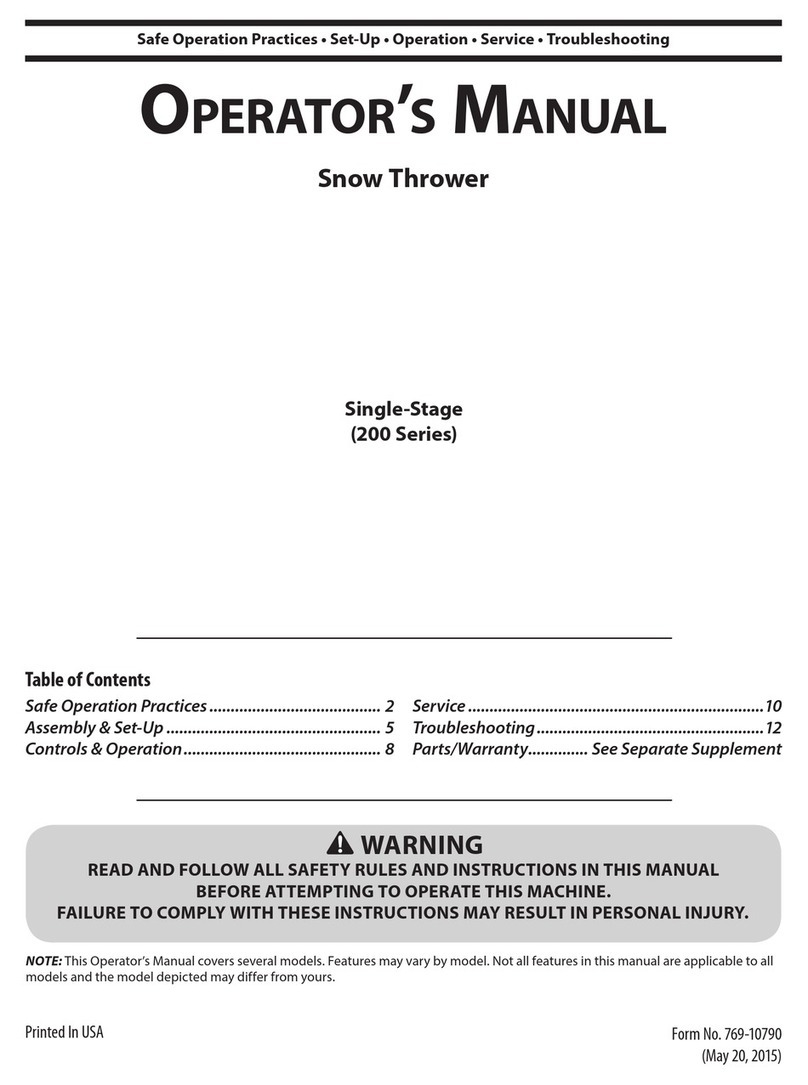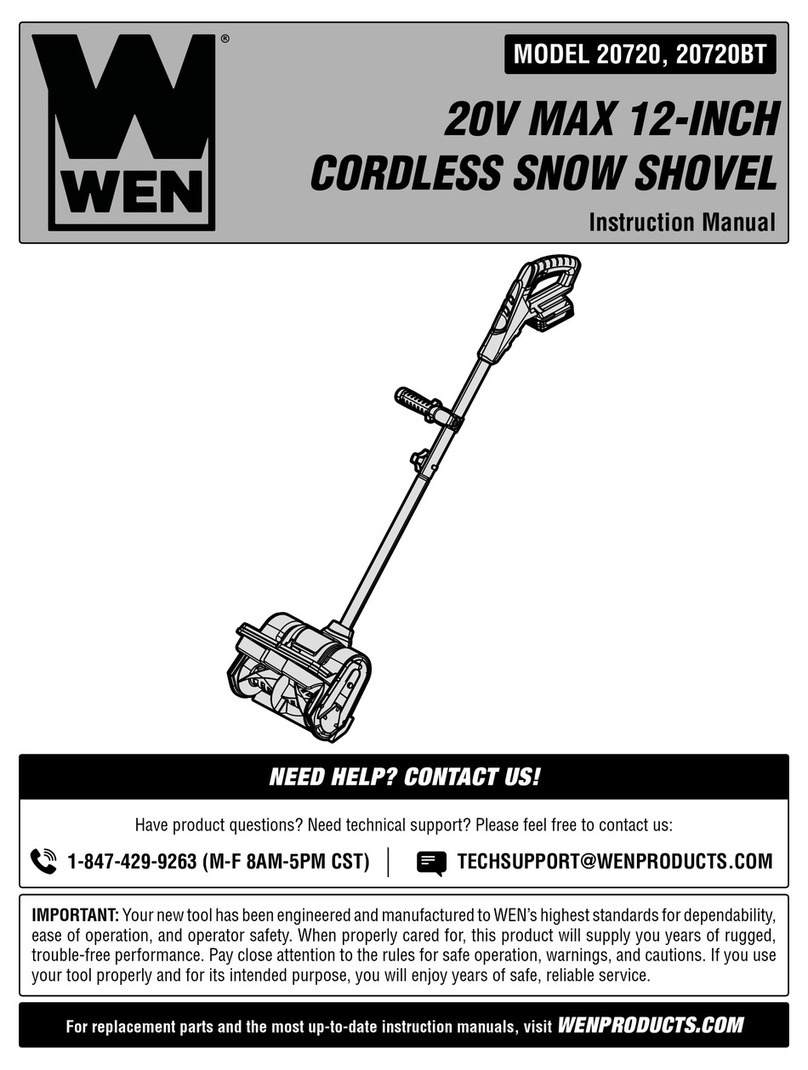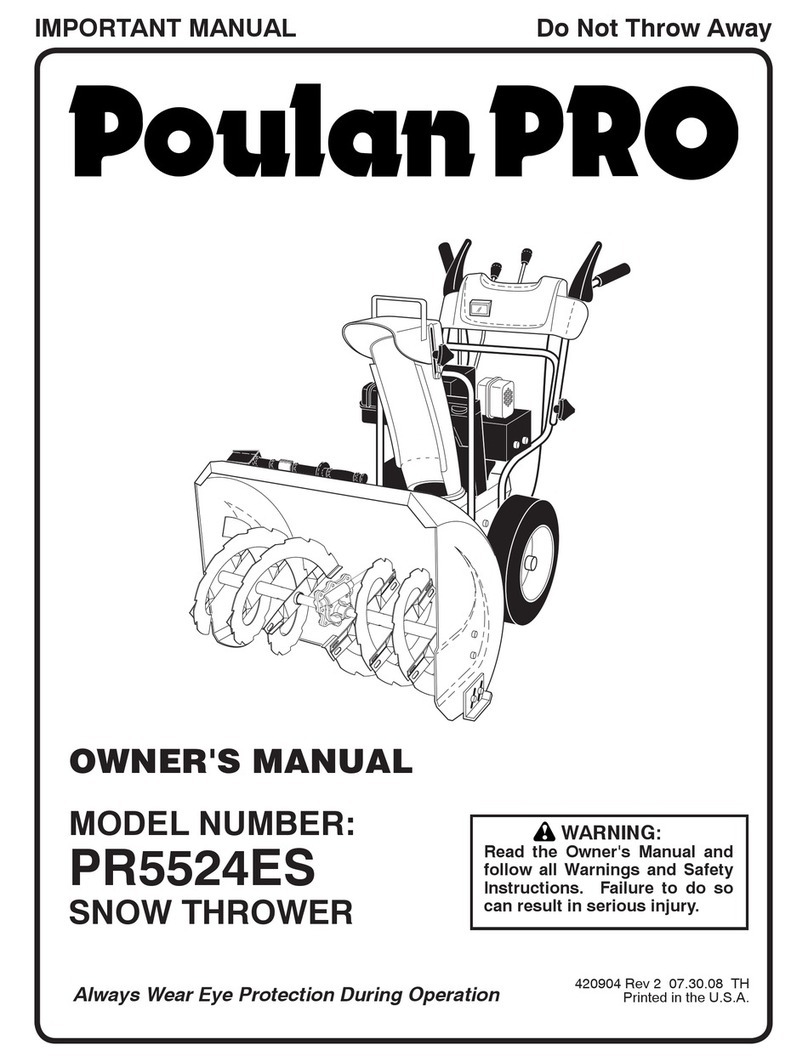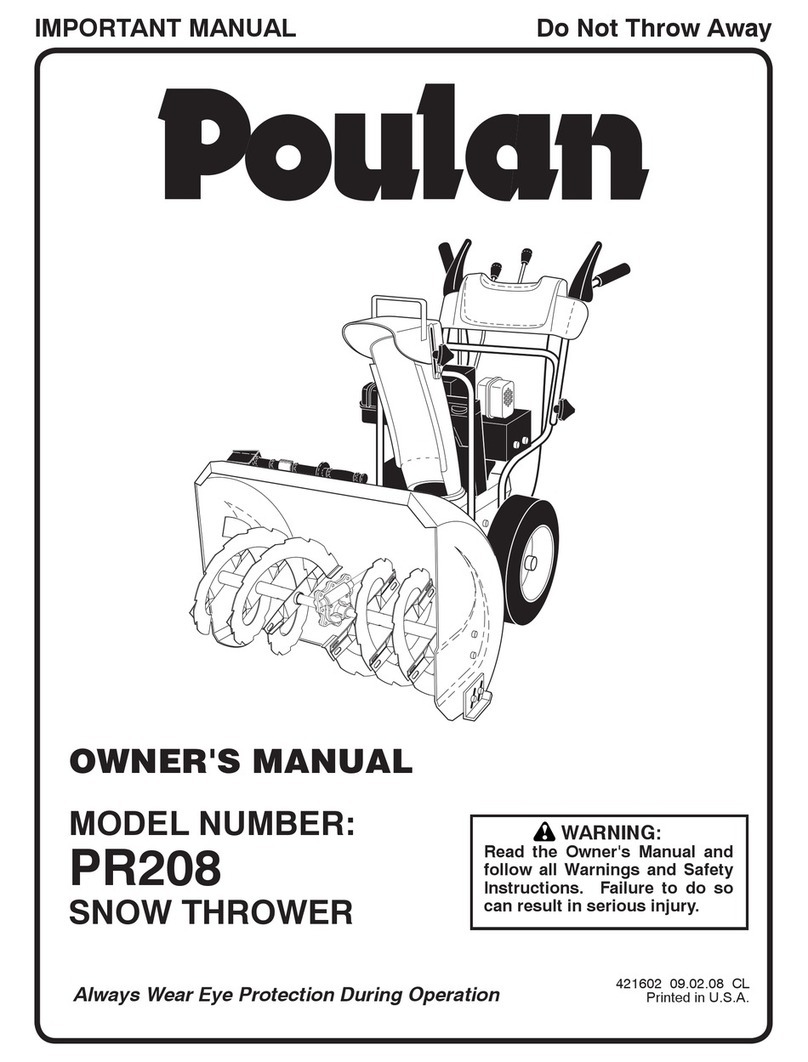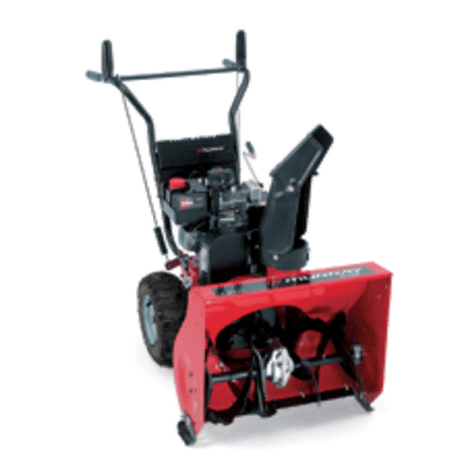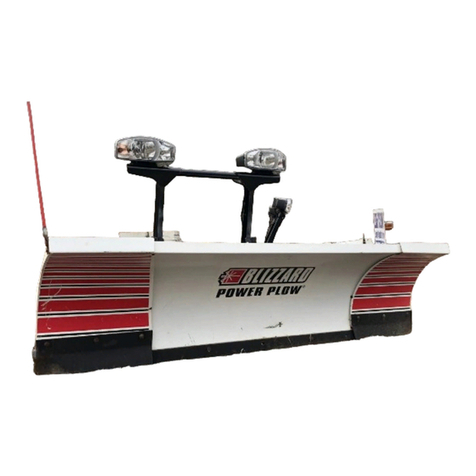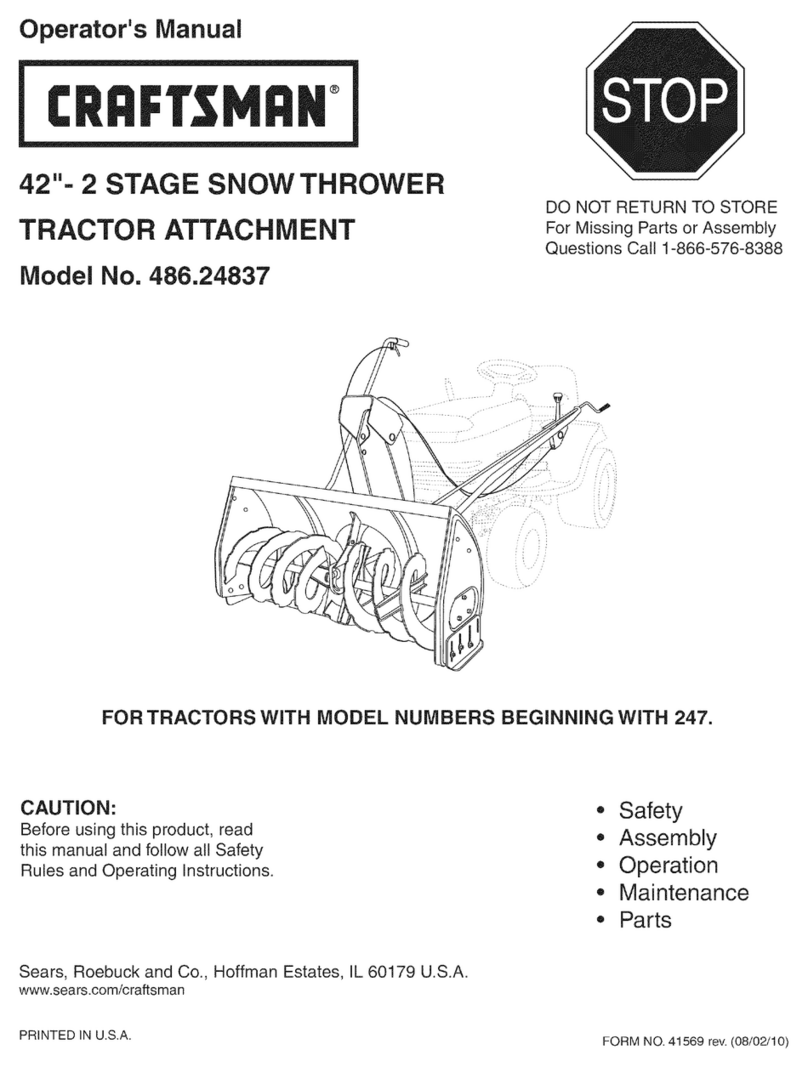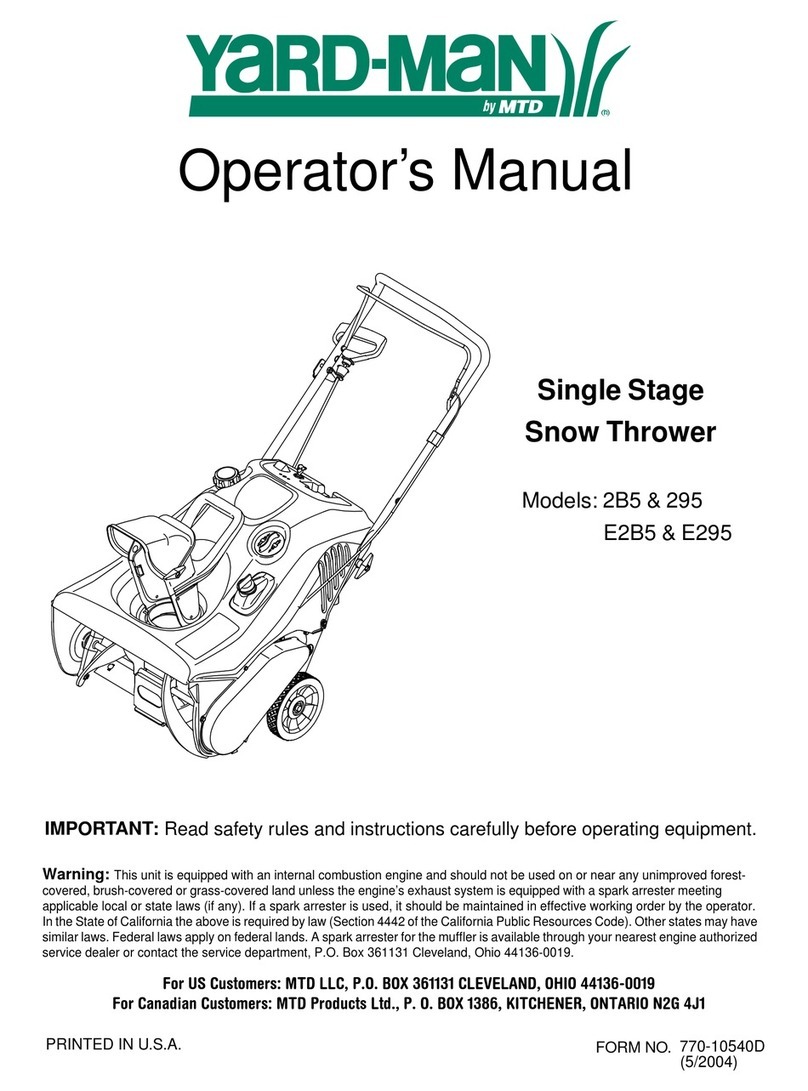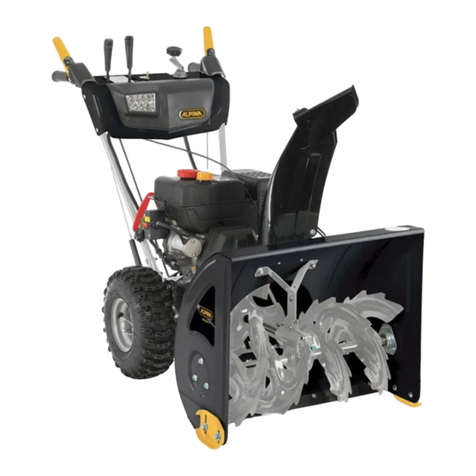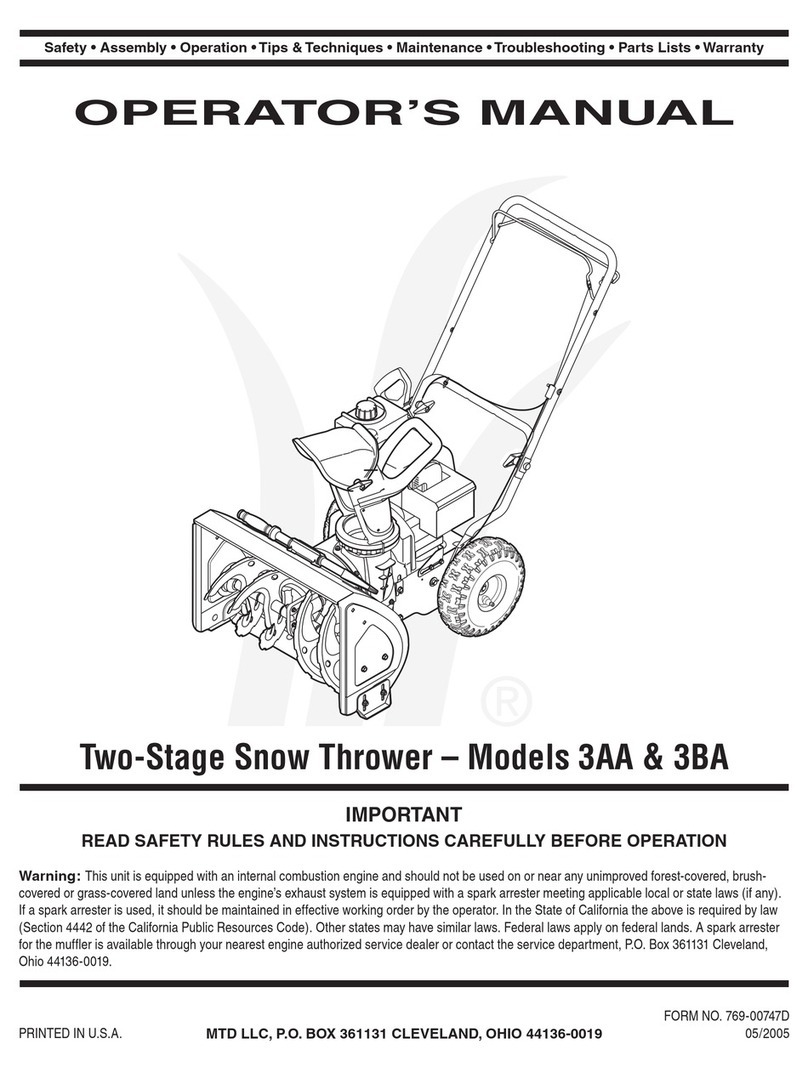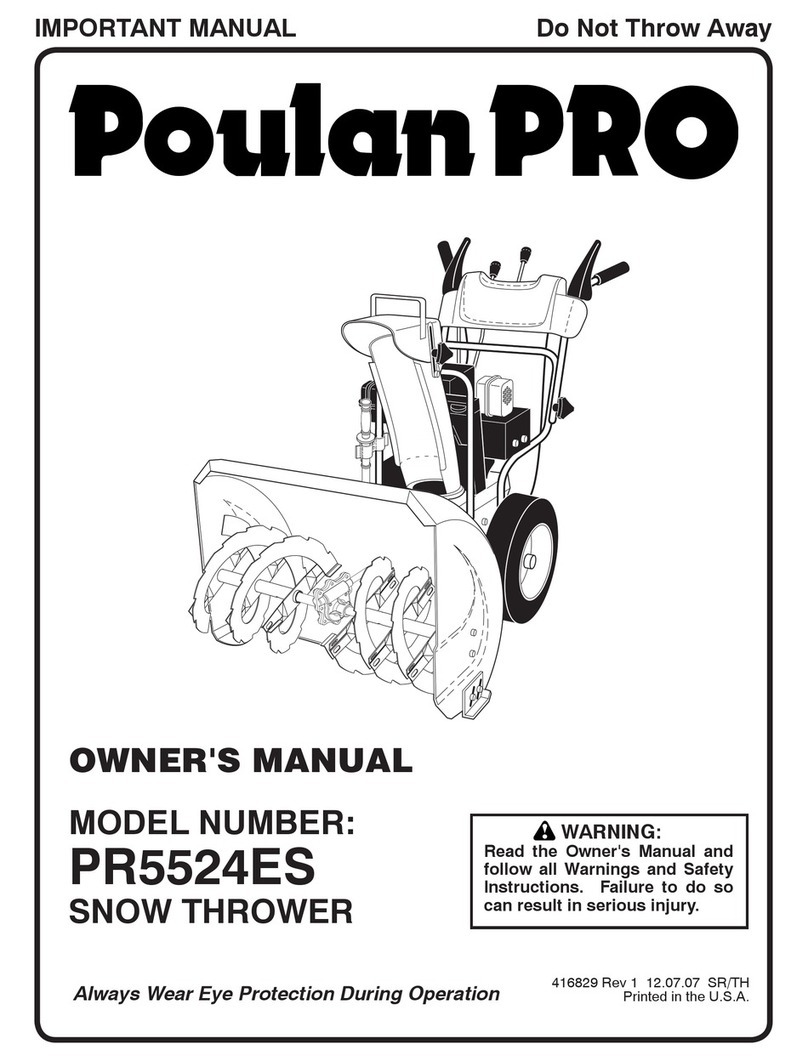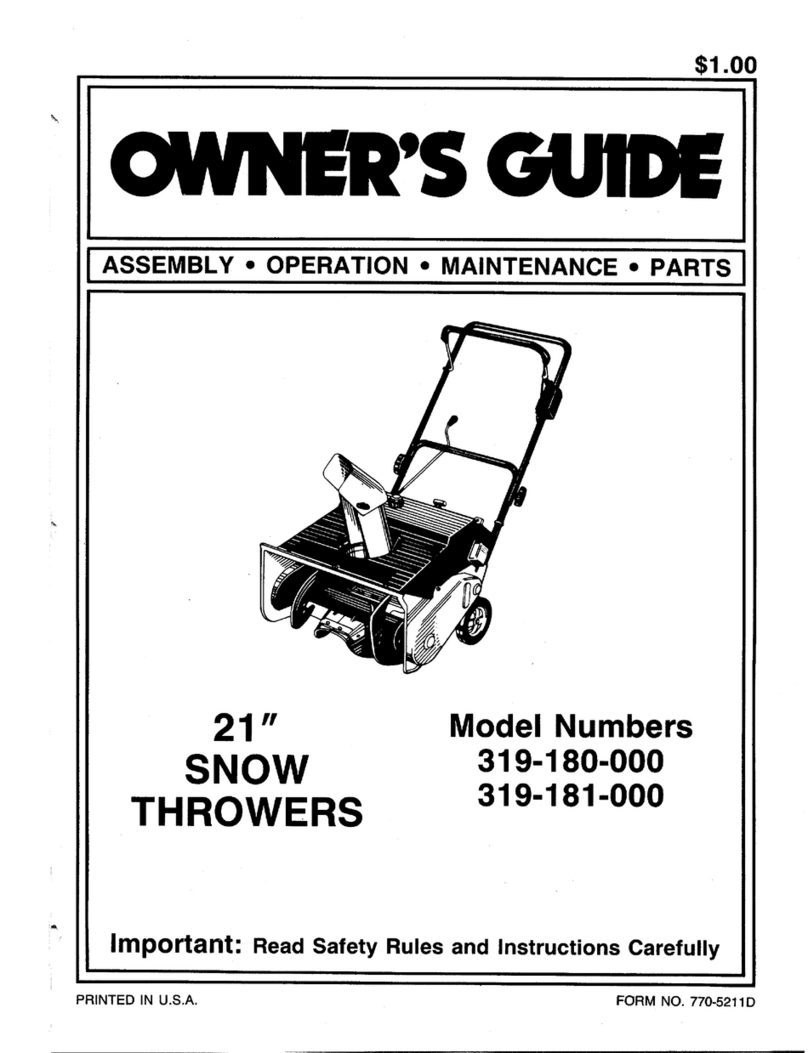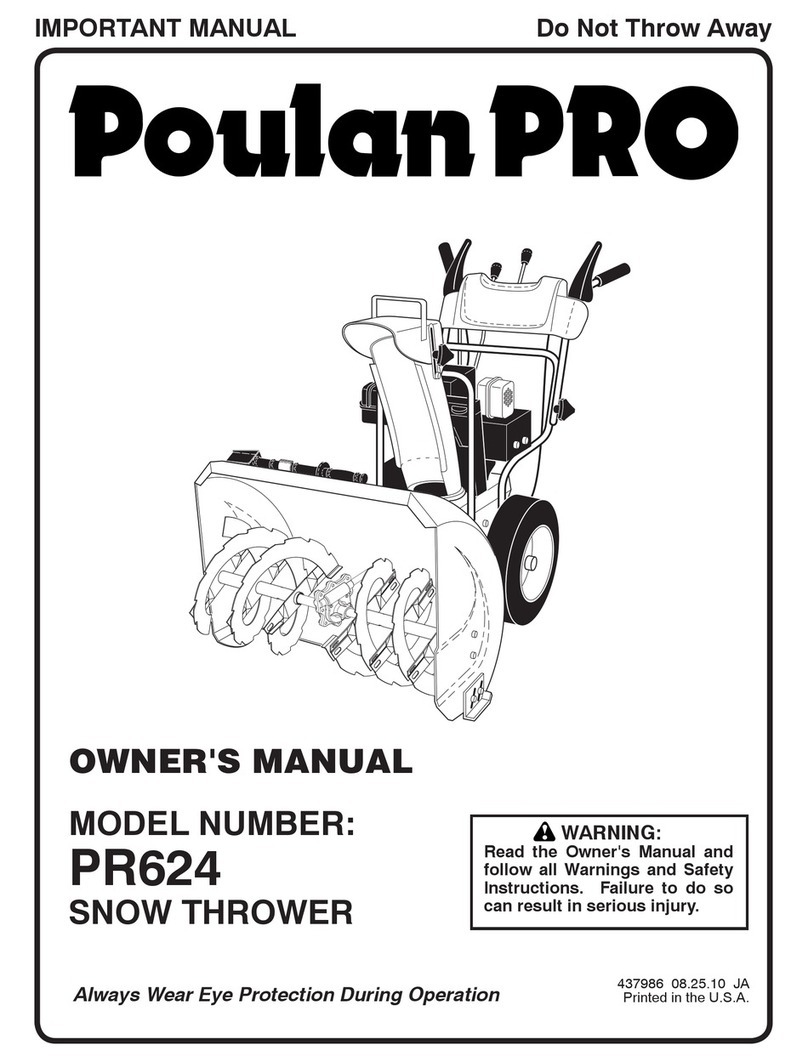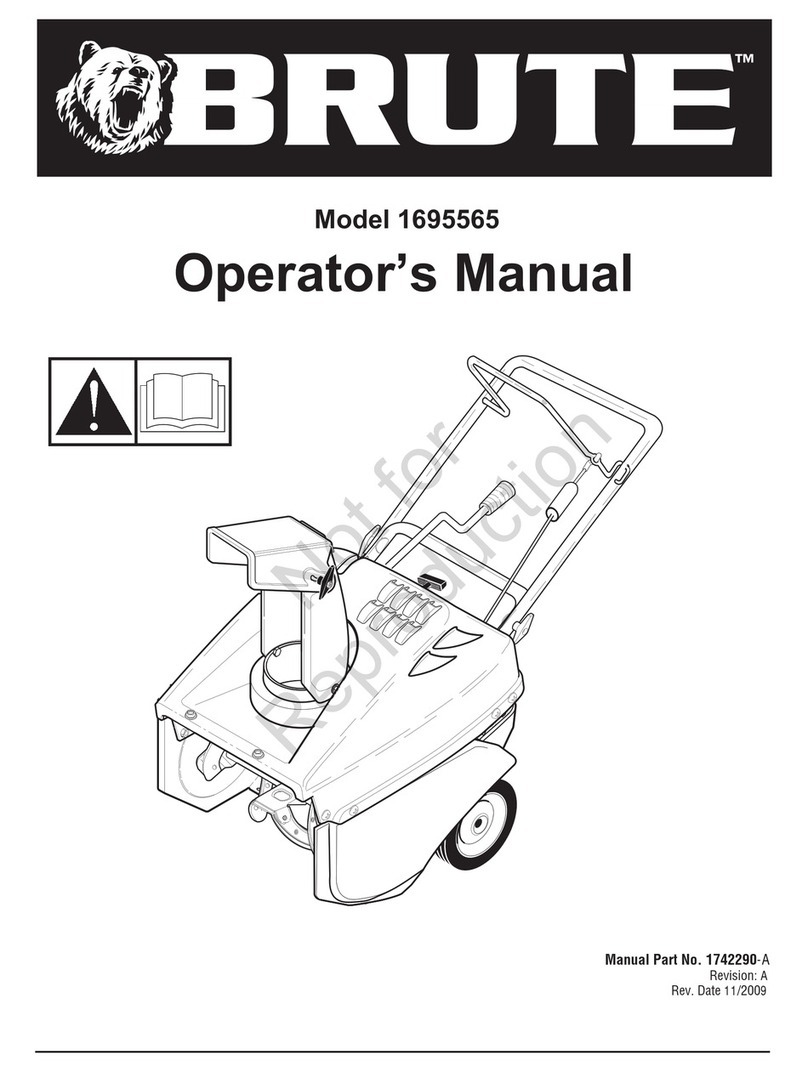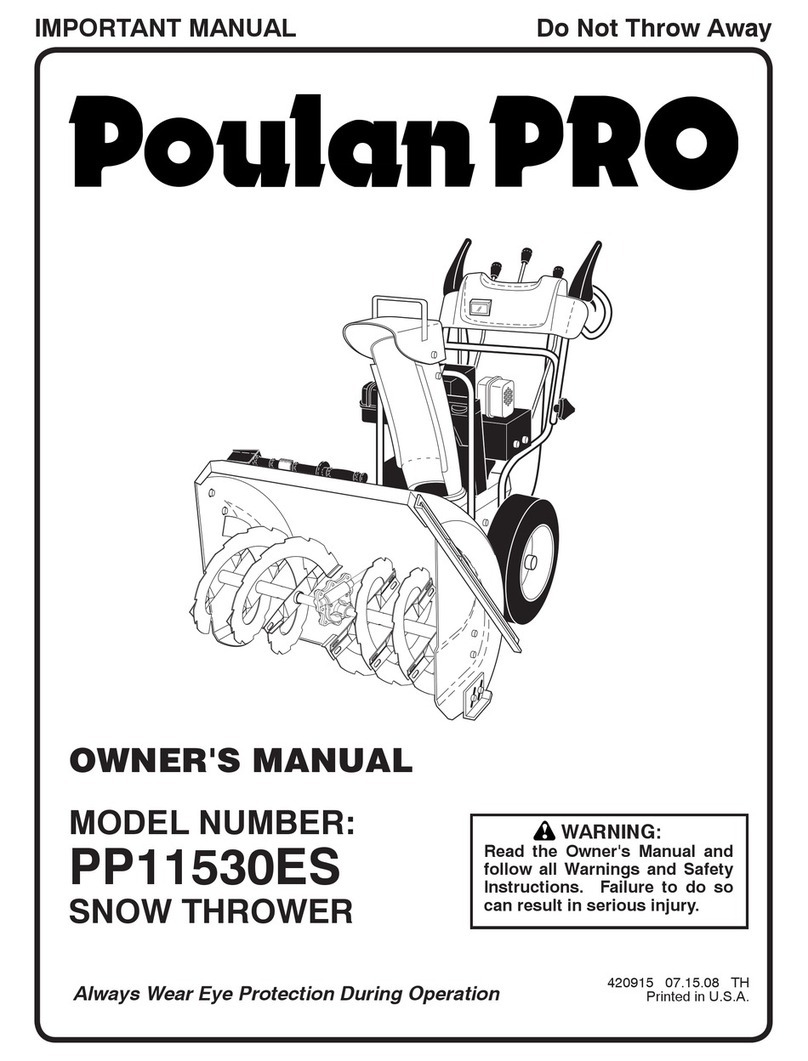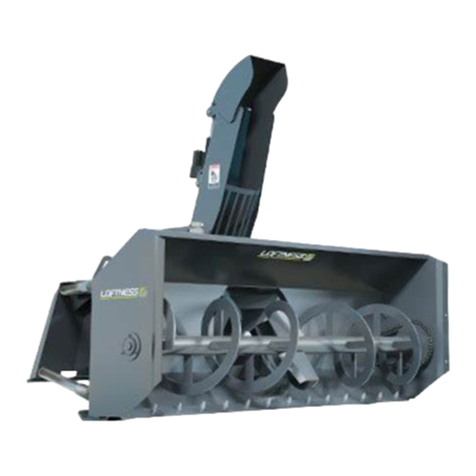Remington 500 User manual

Printed In USA
Safe Operation Practices • Set-Up • Operation • Service • Troubleshooting
WARNING
READ AND FOLLOW ALL SAFETY RULES AND INSTRUCTIONS IN THIS MANUAL
BEFORE ATTEMPTING TO OPERATE THIS MACHINE.
FAILURE TO COMPLY WITH THESE INSTRUCTIONS MAY RESULT IN PERSONAL INJURY.
OperatOr’sManual
Form No. 769-10807
(May 20, 2015)
Safe Operation Practices ........................................ 2
Assembly & Set-Up .................................................. 5
Controls & Operation.............................................16
Service .................................................................... 20
Troubleshooting.................................................... 24
Parts/Warranty.............. See Separate Supplement
Table of Contents
NOTE: This Operator’s Manual covers several models. Features may vary by model. Not all features in this manual are applicable to all
models and the model depicted may differ from yours.
Snow Thrower
2-Stage and 3-Stage
(600 and 500 Series)

Important Safe Operation Practices 1
2
Training
1. Read, understand, and follow all instructions on the machine and
in the manual(s) before attempting to assemble and operate. Keep
this manual in a safe place for future and regular reference and for
ordering replacement parts.
2. Be familiar with all controls and their proper operation. Know how
to stop the machine and disengage them quickly.
3. Never allow children under 14 years of age to operate this
machine. Children 14 and over should read and understand the
instructions and safe operation practices in this manual and on
the machine and be trained and supervised by an adult.
4. Never allow adults to operate this machine without proper
instruction.
5. Thrown objects can cause serious personal injury. Plan your snow-
throwing pattern to avoid discharge of material toward roads,
bystanders and the like.
6. Keep bystanders, pets and children at least 75 feet from the
machine while it is in operation. Stop machine if anyone enters
the area.
7. Exercise caution to avoid slipping or falling, especially when
operating in reverse.
Preparation
Thoroughly inspect the area where the equipment is to be used. Remove
all doormats, newspapers, sleds, boards, wires and other foreign objects,
which could be tripped over or thrown by the auger.
1. Always wear safety glasses or eye shields during operation and
while performing an adjustment or repair to protect your eyes.
Thrown objects which ricochet can cause serious injury to the
eyes.
2. Do not operate without wearing adequate winter outer garments.
Do not wear jewelry, long scarves or other loose clothing, which
could become entangled in moving parts. Wear footwear which
will improve footing on slippery surfaces.
3. Use a grounded three-wire extension cord and receptacle for all
machines with electric start engines.
4. Adjust auger housing height to clear gravel or crushed rock
surfaces.
5. Disengage all control levers before starting the engine.
6. Never attempt to make any adjustments while engine is running,
except where specifically recommended in the operator’s manual.
7. Let engine and machine adjust to outdoor temperature before
starting to clear snow.
Safe Handling of Gasoline
To avoid personal injury or property damage use extreme care in
handling gasoline. Gasoline is extremely flammable and the vapors are
explosive. Serious personal injury can occur when gasoline is spilled on
yourself or your clothes which can ignite. Wash your skin and change
clothes immediately.
1. Use only an approved gasoline container.
2. Extinguish all cigarettes, cigars, pipes and other sources of
ignition.
3. Never fuel machine indoors.
4. Never remove gas cap or add fuel while the engine is hot or
running.
5. Allow engine to cool at least two minutes before refueling.
6. Never over fill fuel tank. Fill tank to no more than ½ inch below
bottom of filler neck to provide space for fuel expansion.
7. Replace gasoline cap and tighten securely.
8. If gasoline is spilled, wipe it off the engine and equipment. Move
machine to another area. Wait 5 minutes before starting the
engine.
9. Never store the machine or fuel container inside where there is an
open flame, spark or pilot light (e.g. furnace, water heater, space
heater, clothes dryer etc.).
10. Allow machine to cool at least 5 minutes before storing.
11. Never fill containers inside a vehicle or on a truck or trailer bed
with a plastic liner. Always place containers on the ground away
from your vehicle before filling.
12. If possible, remove gas-powered equipment from the truck or
trailer and refuel it on the ground. If this is not possible, then
refuel such equipment on a trailer with a portable container,
rather than from a gasoline dispenser nozzle.
13. Keep the nozzle in contact with the rim of the fuel tank or
container opening at all times until fueling is complete. Do not use
a nozzle lock-open device.
Operation
1. Do not put hands or feet near rotating parts, in the auger housing
or chute assembly. Contact with the rotating parts can amputate
hands and feet.
2. The auger control lever is a safety device. Never bypass its
operation. Doing so makes the machine unsafe and may cause
personal injury.
3. The control levers must operate easily in both directions and
automatically return to the disengaged position when released.
4. Never operate with a missing or damaged chute assembly. Keep
all safety devices in place and working.
WARNING! This symbol points out important safety instructions which, if not followed, could endanger the personal safety and/or
property of yourself and others. Read and follow all instructions in this manual before attempting to operate this machine. Failure to
comply with these instructions may result in personal injury. When you see this symbol. HEED ITS WARNING!
DANGER: This machine was built to be operated according to the safe operation practices in this manual. As with any type of power
equipment, carelessness or error on the part of the operator can result in serious injury. This machine is capable of amputating fingers,
hands, toes and feet and throwing foreign objects. Failure to observe the following safety instructions could result in serious injury or
death.
CALIFORNIA PROPOSITION 65
WARNING! Engine Exhaust, some of its constituents, and certain vehicle components contain or emit chemicals known to State of
California to cause cancer and birth defects or other reproductive harm.

3
Section 1 — important Safe operation practiceS
5. Never run an engine indoors or in a poorly ventilated area. Engine
exhaust contains carbon monoxide, an odorless and deadly gas.
6. Do not operate machine while under the influence of alcohol or
drugs.
7. Muffler and engine become hot and can cause a burn. Do not
touch. Keep children away.
8. Exercise extreme caution when operating on or crossing gravel
surfaces. Stay alert for hidden hazards or traffic.
9. Exercise caution when changing direction and while operating on
slopes. Do not operate on steep slopes.
10. Plan your snow-throwing pattern to avoid discharge towards
windows, walls, cars etc. Thus, avoiding possible property damage
or personal injury caused by a ricochet.
11. Never direct discharge at children, bystanders and pets or allow
anyone in front of the machine.
12. Do not overload machine capacity by attempting to clear snow at
too fast of a rate.
13. Never operate this machine without good visibility or light. Always
be sure of your footing and keep a firm hold on the handles. Walk,
never run.
14. Release auger control lever to disengage power to the auger when
transporting or not clearing snow.
15. Never operate machine at high transport speeds on slippery
surfaces. Look down and behind and use care when backing up.
16. If the machine should start to vibrate abnormally, stop the engine,
disconnect the spark plug wire and ground it against the engine.
Inspect thoroughly for damage. Repair any damage before
starting and operating.
17. Disengage all control levers and stop engine before you leave
the operating position (behind the handles). Wait until the auger
comes to a complete stop before unclogging the chute assembly,
making any adjustments, or inspections.
18. Never put your hand in the discharge or collector openings.
Always use the clean-out tool provided to unclog the discharge
opening. Do not unclog chute assembly while engine is running.
Shut off engine and remain behind handles until all moving parts
have stopped before unclogging.
19. Use only attachments and accessories approved by the
manufacturer (e.g. wheel weights, tire chains, cabs etc.).
20. When starting engine, pull cord slowly until resistance is felt, then
pull rapidly. Rapid retraction of starter cord (kickback) will pull
hand and arm toward engine faster than you can let go. Broken
bones, fractures, bruises or sprains could result.
21. If situations occur which are not covered in this manual, use care
and good judgment. Contact Customer Support for assistance and
the name of your nearest servicing dealer.
Clearing a Clogged Discharge Chute
Hand contact with the rotating impeller inside the discharge chute is the
most common cause of injury associated with snow throwers. Never use
your hand to clean out the discharge chute.
To clear the chute:
1. SHUT THE ENGINE OFF!
2. Wait 10 seconds to be sure the impeller blades have stopped
rotating.
3. Always use a clean-out tool, not your hands.
Maintenance & Storage
1. Never tamper with safety devices. Check their proper operation
regularly. Refer to the maintenance and adjustment sections of
this manual.
2. Before cleaning, repairing, or inspecting machine disengage all
control levers and stop the engine. Wait until the auger come
to a complete stop. Disconnect the spark plug wire and ground
against the engine to prevent unintended starting.
3. Check bolts and screws for proper tightness at frequent intervals
to keep the machine in safe working condition. Also, visually
inspect machine for any damage.
4. Do not change the engine governor setting or over-speed the
engine. The governor controls the maximum safe operating speed
of the engine.
5. Snow thrower shave plates and skid shoes are subject to wear
and damage. For your safety protection, frequently check all
components and replace with original equipment manufacturer’s
(OEM) parts only. “Use of parts which do not meet the original
equipment specifications may lead to improper performance and
compromise safety!”
6. Check control levers periodically to verify they engage and
disengage properly and adjust, if necessary. Refer to the
adjustment section in this operator’s manual for instructions.
7. Maintain or replace safety and instruction labels, as necessary.
8. Observe proper disposal laws and regulations for gas, oil, etc. to
protect the environment.
9. Prior to storing, run machine a few minutes to clear snow from
machine and prevent freeze up of auger.
10. Never store the machine or fuel container inside where there is
an open flame, spark or pilot light such as a water heater, furnace,
clothes dryer, etc.
11. Always refer to the operator’s manual for proper instructions on
off-season storage.
12. Check fuel line, tank, cap, and fittings frequently for cracks or
leaks. Replace if necessary.
13. Do not crank engine with spark plug removed.
14. According to the Consumer Products Safety Commission (CPSC)
and the U.S. Environmental Protection Agency (EPA), this product
has an Average Useful Life of seven (7) years, or 60 hours of
operation. At the end of the Average Useful Life have the machine
inspected annually by an authorized service dealer to ensure that
all mechanical and safety systems are working properly and not
worn excessively. Failure to do so can result in accidents, injuries
or death.
Do not modify engine
To avoid serious injury or death, do not modify engine in any way.
Tampering with the governor setting can lead to a runaway engine and
cause it to operate at unsafe speeds. Never tamper with factory setting
of engine governor.
Notice Regarding Emissions
Engines which are certified to comply with California and federal EPA
emission regulations for SORE (Small Off Road Equipment) are certified
to operate on regular unleaded gasoline, and may include the following
emission control systems: Engine Modification (EM), Oxidizing Catalyst
(OC), Secondary Air Injection (SAI) and Three Way Catalyst (TWC) if so
equipped.

4Section 1 — important Safe operation practiceS
WARNING! Your Responsibility—Restrict the use of this power machine to persons who read, understand and
follow the warnings and instructions in this manual and on the machine.
SAVE THESE INSTRUCTIONS!
Safety Symbols
This page depicts and describes safety symbols that may appear on this product. Read, understand, and follow all instructions on the machine before
attempting to assemble and operate.
Symbol Description
READ THE OPERATOR’S MANUAL(S)
Read, understand, and follow all instructions in the manual(s) before attempting to
assemble and operate.
WARNING— ROTATING BLADES
Keep hands out of inlet and discharge openings while machine is running. There are rotating
blades inside.
WARNING— ROTATING BLADES
Keep hands out of inlet and discharge openings while machine is running. There are rotating
blades inside.
WARNING— ROTATING AUGER
Do not put hands or feet near rotating parts, in the auger housing or chute assembly.
Contact with the rotating parts can amputate hands and feet.
WARNING—THROWN OBJECTS
This machine may pick up and throw objects which can cause serious personal injury.
WARNING—GASOLINE IS FLAMMABLE
Allow the engine to cool at least two minutes before refueling.
WARNING— CARBON MONOXIDE
Never run an engine indoors or in a poorly ventilated area. Engine exhaust contains carbon
monoxide, an odorless and deadly gas.
WARNING— ELECTRICAL SHOCK
Do not use the engine’s electric starter in the rain.
WARNING— HOT SURFACE
Engine parts, especially the muffler, become extremely hot during operation. Allow engine
and muffler to cool before touching.

Assembly & Set-Up 2
5
Thank you for purchasing this product. It was carefully engineered to
provide excellent performance when properly operated and maintained.
Please read this entire manual prior to operating the equipment. It instructs
you how to safely and easily set up, operate and maintain your machine.
Please be sure that you, and any other persons who will operate the
machine, carefully follow the recommended safety practices at all times.
Failure to do so could result in personal injury or property damage.
All information in this manual is relative to the most recent product
information available at the time of printing. Review this manual frequently
to familiarize yourself with the machine, its features and operation. Please
be aware that this Operator’s Manual may cover a range of product
specifications for various models. Characteristics and features discussed
and/or illustrated in this manual may not be applicable to all models. We
reserve the right to change product specifications, designs and equipment
without notice and without incurring obligation.
If applicable, the power testing information used to establish the power
rating of the engine equipped on this machine can be found at www.opei.
org or the engine manufacturer’s web site.
If you have any problems or questions concerning the machine, phone your
local authorized service dealer or contact us directly. We want to ensure
your complete satisfaction at all times.
Throughout this manual, all references to right and left side of the machine
are observed from the operating position.
Thank You
Contents of Carton
• Snow Thrower (1) • Chute Assembly (1) • Chute Control Rod, Flex Shaft, or Side
• Replacement Auger Shear Pins (2-4) • Safety Key (2) Crank Rod Assembly† (1)
• Snow Thrower Operator’s Manual (1) • Engine Operator’s Manual (1) • Parts/Warranty Document (1)
• Product Registration Card (1) † If Equipped
NOTE: This Operator’s Manual covers several models. Features may vary by model. Not all features in this manual are applicable to all models and the
model depicted may differ from yours. Refer to Figure 2-1 which shows the different versions and match the contents of carton (chute and directional
control rod/flex shaft) to identify your specific unit.
Overhead Chute Control
(with Flex Shaft and Steel Chute)
Page 12
Electric Chute Control
Pages 13
U-Joint Side Crank Chute Control
Page 8
Two & Four Way Chute Control
Pages 10 -11
Overhead Chute Control (with Chute Control Rod)
Page 9
Standard Side Crank Chute Control
Standard Side Crank
Rod Assembly
U-Joint Side Crank
Rod Assembly Overhead Chute
Control Rod
Chute Control Rod
Flex Shaft
Manual Chute
Control Rod
Chute
Assembly
Chute
Assembly
Chute
Assembly
Chute Assembly
Chute Assembly
Chute
Assembly
Page 7
Figure 2-1
Other manuals for 500
1
This manual suits for next models
1
Table of contents
Other Remington Snow Blower manuals
